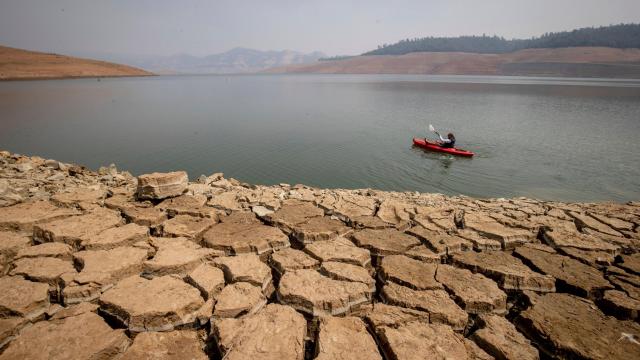As if the dire water situation in the West wasn’t bad enough, it could get even worse. California’s water use could actually drive up carbon emissions if water efficiency measures aren’t taken.
A new report, released Thursday from nonprofit think tank Next 10 and researchers at the Pacific Institute, estimates that if California’s water demand and use stay the same, population growth means that urban water demand could increase 24% by 2035. That, in turn, could drive up water-related electricity use by 21% over that same time period, with an accompanying 25% increase in natural gas use.
Keeping water flowing and available around a state as big as California takes a lot of energy. California’s State Water Project, the state storage and delivery system, is the single largest consumer of electricity in the state. Previous studies have estimated that all the systems designed to deliver and treat water for the state’s population account for a whopping 20% of California’s electricity use each year. The system requires 88 billion gallons of diesel each year, with a large chunk devoted to groundwater pumping. Hot water heaters also burn a third of the state’s natural gas that’s not fed into power plants.
“In California, we have a great aqueduct system of moving water, and you need a lot of pumps to move the water,” said Noel Perry, the founder of Next 10. “It’s very mechanical. In order to move it, you need electricity to power these machines and pumps to move the water. Then, every house has a way of heating water, and most of the ways in which it’s heated is natural gas. Then, with things like wastewater treatment plants, you need to move the water into the plant, process the water, and move it out. That all takes electricity to perform those processes.”
Not all water use is created equal. While agriculture takes up a lot of actual water resources in California, urban indoor water use is much more energy-intensive. That makes sense: People using water in their homes need it cleaned, heated, treated, and disposed of. Farmers and ranchers have, in recent years, been forced to pump more as groundwater levels decline — which uses up electricity — but urban water use is still twice as energy-intensive as agricultural use, the report found.
Some solutions are being developed and popularised to create new water sources for urban populations, like desalination and treating used water. In terms of energy use, these options are better than transporting water long distances, the report said, but they’re still more energy-intensive than drawing from a well-managed reservoir that can be better maintained with efficiency measures.
Making small improvements in how much water homes in California flush down the toilet, for instance, may seem like small potatoes. But wastewater treatment alone currently uses up about 1% of U.S. electricity. Reducing the amount of water treated may seem small in the grand scheme of the climate crisis, but every ton of carbon not emitted counts.
And fortunately, there’s a lot of room for improvement with California’s water system. Implementing widespread conservation and efficiency efforts, the report said, could reduce water-related electricity usage 19% by 2035, as well as decrease natural gas usage by 16%. That would cut greenhouse emissions by 41%, putting the state closer to meeting its climate goals. Some of the top recommendations include electrifying water heaters to move entirely off natural gas and creating more energy-efficient pumps for groundwater. There are even nifty suggestions for capturing gas from waste decomposition and then using that gas to power wastewater treatment.
But there’s also the simple maths of water conservation: Using less water overall means using less electricity to move it around and deliver it. Perry ticked off some common-sense practices and reforms that can lower water’s carbon footprint in people’s homes, like planting native, less-water-intensive plants in yards and using more energy-efficient appliances that take less water to do the same job. These same reforms are often touted as necessary to make sure there’s more water for everyone in the future.
Climate change is exacerbating the megadrought hitting the West, and the Intergovernmental Panel on Climate Change report issued last month found that climate change is making serious droughts much more common. When it comes to making water make sense in the West, it’s clear that energy and conservation can go hand-in-hand.
